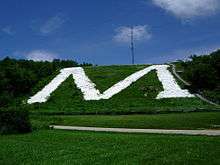
Platte Mound M
The Platte Mound M is the letter "M" written using whitewashed stones on Platte Mound about four miles east of Platteville, Wisconsin. It is the largest letter "M" in the world. The letter is 241 feet (73 m) high, 214 feet (65 m) wide, with legs 25 feet (7.6 m) wide.
History
University of Wisconsin-Platteville students Raymond Medley and Alvin Knoerr worked at a Colorado mine in the summer of 1936, where they saw a large letter "M" on the side of a hill that signified mining. They believed that a larger "M" should be written on the Platte Mound to represent Platteville miners. They created the first letter on the mound that winter. They wrote the letter "M" in deep snow, and it was visible for several weeks when a cold spell hit the area. The letter "M" was selected for the School of Mines at the university. Several students who went hiking in the same spot after the snow melted used large rocks to build one leg of a letter "M" while resting. The unfinished letter was so pronounced that engineering department head, H. B. Morrow, declared a field day for the department personnel and engineering students to complete the "M". Seniors surveyed the letter to make sure that it was larger than the "M" in Colorado. Underclassmen constructed the letter using borrowed picks, crowbars, and wheelbarrows from a local CCC camp. The letter was constructed from limestone found on the mound. Morrow and other professors drove several miles away to inspect the work from a distance, and they recommended changes to counteract distortion from the slope of the mound. Work was completed about six months later and the letter was celebrated at that year's homecoming on October 16, 1937. It was lit from a torch that was relayed 4.5 miles (7.2 km) from the school's Tech building. The illuminated letter was visible from 28 miles away.

Mound
A mound is an artificial heaped pile of earth, gravel, sand, rocks, or debris. The most common use is in reference to natural earthen formation such as hills and mountains, particularly if they appear artificial. The term may also be applied to any rounded area of topographically higher elevation on any surface. Artificial mounds have been created for a variety of reasons throughout history, including ceremonial (platform mound), burial (tumulus), and commemorative purposes (e.g. Kościuszko Mound).
Archaeology
North American archaeology
In the archaeology of the United States and Canada, the term "mound" has specific and technical connotations. In this sense, a mound is a deliberately constructed elevated earthen structure or earthwork, intended for a range of potential uses. In European and Asian archaeology, the word "tumulus" may be used as a synonym for an artificial hill, particularly if the hill is related to particular burial customs.
While the term "mound" may be applied to historic constructions, most mounds in the United States are pre-Columbian earthworks, built by Native American peoples. Native Americans built a variety of mounds, including flat-topped pyramids or cones known as platform mounds, rounded cones, and ridge or loaf-shaped mounds. Some mounds took on unusual shapes, such as the outline of cosmologically significant animals. These are known as effigy mounds. Some mounds, such as a few in Wisconsin, have rock formations, or petroforms within them, on them, or near them.
Mound (disambiguation)
A mound is an artificial heap or pile, especially of earth, rocks, or sand.
Mound and Mounds may also refer to:
In places:
See also:

Rift (album)
Rift is the fourth official studio album by the American rock band Phish. It is the band's second concept album, the first being The Man Who Stepped into Yesterday in 1987, which has never been officially released. Rift's songs convey the experience of a man dreaming about the rift in his relationship with his girlfriend. Recorded in September and October 1992 and produced by Muscle Shoals music veteran Barry Beckett, the album was released by Elektra Records on February 2, 1993.
All songs were written by Trey Anastasio and Phish lyricist Tom Marshall except "Mound" and "Weigh" by bass guitarist Mike Gordon and "Lengthwise" by drummer Jon Fishman.
The instrumental, "All Things Reconsidered", is an intentional variation on the theme to the National Public Radio news show All Things Considered, and has been featured on the show itself several times. An orchestral version of the song appears on Trey Anastasio's 2004 solo album Seis De Mayo.
The cover art was created by New York-based painter David Welker, who worked closely with the band during winter 1993 in order to visually depict each of the album's tracks in a single image, with the notable exception of "The Horse". (For this reason, a horse intentionally appears on the cover of Phish's next album, Hoist). Relix magazine listed Rift as one of the most iconic album covers of all time in 2007.
Podcasts:

